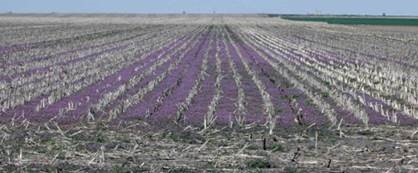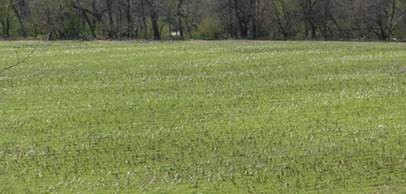If you are a no-till or strip-till grower you probably have experience dealing with winter annual weeds like chickweed and henbit. Winter annual weeds germinate in the fall and then finish their life cycle by flowering and making seed in early spring. The springs of 2016 and 2017 were bad years for winter annuals in Central Illinois.
Remember all the “purple henbit fields” in late February and early March? We typically don’t see winter annual pressure in fields that are tilled in the fall, UNLESS that tillage takes place very early in the fall. If you made a tillage pass immediately following corn or soybean harvest, those fields could see pressure from winter annual weed species germinating in late fall.
The other winter annual weed frequently seen in Illinois is common chickweed. A heavy infestation of common chickweed is seen in the photo to the right.
Chickweed has a very distinct green color. There are also many other winter annual weeds including purple deadnettle, pennycress and shepherds’ purse. This discussion encompasses all winter annual weeds.
However, a note of caution, soybean cyst nematodes can reproduce on the roots of several winter annual weeds but never on the roots of conventional winter cover crops.
Natural Cover Crop: You may be wondering why these winter annual weeds are bad. Aren’t these “kind of” a natural cover crop? In a way they are a natural cover crop, however, one difference between winter annual weeds and a cover crop is that we can EASILY TERMINATE the cover crop in the spring. Conversely, winter annual weeds are very difficult to control by the time the weather allows us to apply a herbicide in the spring, or even if you decided to control them with tillage in the early spring.
Remember—it is always much easier to control a young, actively growing weed and because these weeds are winter annuals they are young and actively growing this time of year! That is why fall is the proper time to control these weeds with a herbicide program, and why they are so hard to control in the spring. I like to say that controlling winter annuals in the spring is like trying to control a giant ragweed in August.
This is one recipe for controlling winter annuals. Timing: Autumn Super™ can be applied after the crop is harvested.
- Autumn Super 0.3 oz.
- 2,4D 1–1.5 pints
- Crop Oil 1% v/v
- MS 1.5 lbs./A
The value of a fall-applied program: As discussed above, a fall-applied herbicide program is the best way to control these pesky winter annual weeds because it not only controls any winter annual weeds that have emerged, but also has RESIDUAL control of later emerging winter annual weeds. If winter annual weeds emerge late, a tillage pass will not be as effective as a fall herbicide application.
Another benefit to controlling winter annual weeds is that this helps with soybean cyst nematode populations. It has been documented that certain winter annual weeds influence soybean cyst nematodes populations by allowing reproduction on their roots.
One of the main questions I get about fall herbicides is whether they will help control spring weeds like waterhemp. My answer is simple: a fall-applied herbicide treatment replaces a fall tillage pass for control of winter annual weeds. Will a tillage pass in the fall help control waterhemp in the spring? Obviously, the answer is no, so neither will a fall-applied herbicide treatment.
Worried about locking yourself into a certain crop if you spray in the fall? This can be a problem with some fall-applied herbicides, so do your homework and select the herbicide best suited for your operation.



